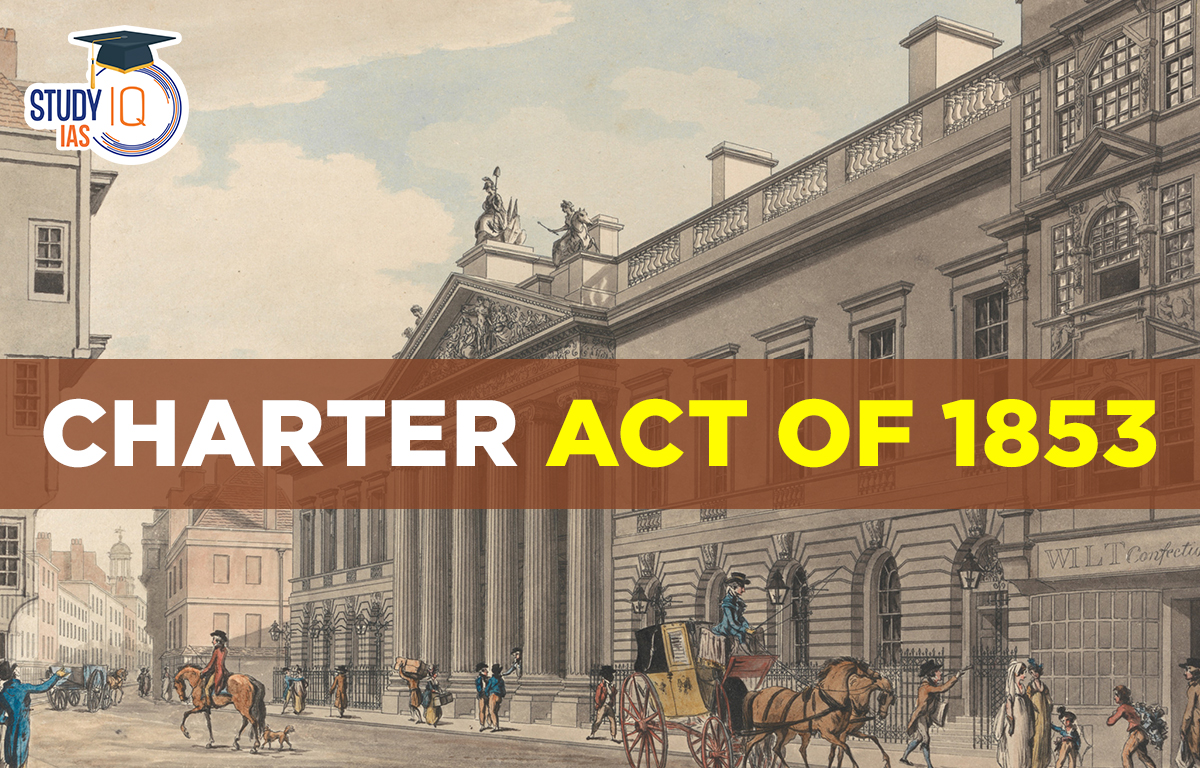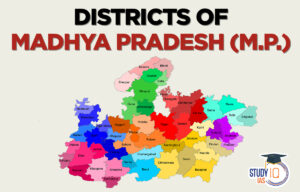Table of Contents
The Charter Act of 1853 was an important legislative reform enacted by the British Parliament, which profoundly influenced the administration of British India. It was the final Charter Act relating to the East India Company and brought in progressive changes in the administration. The act formed the basis of the modern Indian legislative system and marked the start of the end of the Company’s rule.
Here in this article, we will discuss the History, Objectives, Features, and Provisions of the Charter Act 1853, which are very much relevant to UPSC, State PSC, and other government examinations.
The Charter Act 1853
Read all about the Charter Act 1853. The East India Company‘s last charter act was the one from 1853. In contrast to preceding charter acts from 1793, 1813, and 1833, which extended the charter for 20 years, the Charter Act of 1853 reaffirmed the Company’s authority and permitted it to keep the territories and revenues of Indian lands in the trust of the Crown for an unspecified amount of time.
When the Charter Act of 1853 was passed, Lord Dalhousie was the Governor-General of India. The Charter Act of 1853 is extremely important since it inaugurated India’s parliamentary system. This article goes into great detail about the topic “Charter Act of 1853,” which is a significant component of the syllabus for the Indian Polity and Governance section of the UPSC/IAS Exam.
The Charter Act 1853 History
Due to the court of directors and board of control’s attendance, the delivery business has been delayed and overextended. The British East India Company had previously acquired Sind and Punjab as well as some other Indian states; therefore, there were territorial and political changes in India following the Charter Act of 1833.
Concerns were also expressed regarding the Governor-General of India’s function as Governor of Bengal because it influences some decisions in Bengal’s favor. Decentralization of power and including the Indians in the running of their affairs were also demanded.
The British parliament agreed to renew the East India Company’s charter in 1853 based on the aforementioned factors. The Company appointed two Committees to investigate the Company’s affairs in the prior year. Their findings were used to create and pass the Charter Act of 1853.
Objective of the Charter Act of 1853
The main objectives of the Charter Act of 1853 were:
-
To introduce administrative reforms in the governance of British India.
-
To separate legislative and executive powers in the Governor-General’s Council.
-
To establish a formal legislative body with representative elements.
-
To create a merit-based civil service through open competitive examinations.
-
To reduce the autonomy of the East India Company and increase Parliament’s oversight.
-
To lay the groundwork for a modern, efficient, and accountable administration.
The Charter Act 1853 Feature
Here are the key features of the Charter Act 1853:
| Feature | Description |
|---|---|
| No Fixed Tenure for the Company | The East India Company’s charter was renewed without a specific time limit. |
| Separation of Powers | Legislative and executive functions of the Governor-General’s Council were separated. |
| Expansion of Legislative Council | Added 6 new legislative members; created a distinct Indian Legislative Council. |
| Open Competitive Exams for Civil Services | Civil Services recruitment was opened through merit-based competitive exams. |
| Local Representation Introduced | Council included representatives from Madras, Bombay, Bengal, and Agra. |
| Governor-General’s Legislative Powers | Empowered to appoint a Vice-President and held veto power over legislation. |
| Crown Control over Directors | 6 of 18 Directors of the East India Company were to be nominated by the Crown. |
| Separate Governor for Bengal | Created a distinct Governor for Bengal, separating the post from the Governor-General. |
| Provision for New Presidencies | Authorized the Court of Directors to create new presidencies and provinces. |
| Financial Responsibility | The Company was made liable to pay for administrative expenses including salaries. |
The Charter Act 1853 Provisions
1. Legislative Powers
The executive and council functions of the Governor-legislative General were divided for the first time. Six new legislative councilors, as they were referred to, were to be added to the council. In other words, it established a unique Governor General’s Legislative Council that was later referred to as the Indian (Central) Legislative Council.
The legislative part of the council operated like a miniature Parliament and adhered to the same rules as the British Parliament. Legislation was for the first time viewed as a separate government function requiring particular tools and practices. The Governor-Council General’s was required to follow the same legislative process as the British Parliament. Members have the opportunity to discuss and raise questions about the Executive Council’s policies.
The Executive Council was granted the authority to veto any legislation passed by the Council acting as its legislative body. The legislative proceedings were open to the public, and the debate was oral. Bills weren’t referred to specific members but rather to the Select Committee.
2. Salary of the Members
The Charter Act of 1853 stated that the Company would be responsible for paying the salaries of the Board of Control members, its Secretary, and other officers.
3. Reduce in Number of Directors and their Power
The number of court of directors members was decreased from 24 to 18, with 6 of those members must be proposed by the Crown. Under the Act of 1853, the Court of Directors lost its patronage authority, and top positions became subject to competitive examinations without regard to caste, creed, or religion.
This plan was put into effect by the Macaulay Committee, also known as the Committee for the Indian Civil Service, in 1854. It was permitted for the Court of Directors to elect a new President. According to the Act, the court of directors could potentially change the borders of the current states and include the newly acquired state. In the year 1859, a separate Lieutenant Governorship for Punjab was established thanks to this provision.
4. Powers Regarding Law Commission
This plan was put into effect by the Macaulay Committee, also known as the Committee for the Indian Civil Service, in 1854. It was permitted for the Court of Directors to elect a new President. According to the Act, the court of directors could potentially change the borders of the current states and include the newly acquired state. In the year 1859, a separate Lieutenant Governorship for Punjab was established thanks to this provision.
5. Power for the Presidency
A separate Governor for the Presidency of Bengal was to be appointed, but until that time, the Court of Directors might give the Governor-General of India in Council permission to appoint a covenant employee with ten years of service as the province’s Lieutenant-Governor. Since it was the less expensive of the two, the latter appointment was made.
The Court of Directors was given the authority to elect a new Presidency. Additionally, authority was granted to periodically modify and regulate the boundaries of the several provinces. Using this authority, Punjab was transformed into a Lieutenant-Governorship.
6. Open Competition System
To hire and select civil servants, it established an open competition system. Indians were thus given access to the covenanted civil service as well. The Macaulay Committee, sometimes known as the Committee on Indian Civil Service, was established in 1854.
The Charter Act 1853 Significance
The Charter Act of 1853 made it abundantly evident that the Company’s rule would not survive for an extended period. The sharp division between the Legislative and Executive Councils, which signals the start of India’s Parliamentary system, is one of its defining characteristics.
The Bengali government released the Governor-General from its oversight responsibilities, and he began working for the Indian government. The Charter Act of 1853 establishes and regulates the Legislative Council, which is regarded as a crucial constitutional provision.
-
Laid the foundation for the modern legislative structure in India.
-
Opened civil services to talent-based recruitment, leading to a professional bureaucracy.
-
Increased British Parliament’s control and oversight over Indian affairs.
-
Marked the beginning of the end of the East India Company’s rule.
-
Introduced systematic decentralization and local involvement in governance.
The Charter Act 1853 Criticism
One of the most significant flaws of the Charter Act of 1853 was the exclusion of Indians from the Legislative Council. The Charter Act of 1853 provided the Home Government the chance to step in and take the East India Company’s position in India because it did not grant the East India Company the authority to rule India for another 20 years. Things that happened in 1857, or the so-called “Mutiny,” accelerated this process.
-
No real Indian representation: Indians were not included in the legislative or executive wings.
-
Power still centralized: Governor-General retained final authority.
-
Barriers to Indian participation in civil services: exams were conducted in Britain only.
-
No timeline for reforms: the indefinite charter allowed uncertainty and ambiguity.
-
Foreshadowed imperial takeover: helped pave the way for the 1858 transfer of power to the Crown.
The Charter Act 1853 UPSC
One of the most significant flaws of the Charter Act of 1853 was the exclusion of Indians from the Legislative Council. The Charter Act of 1853 provided the Home Government the chance to step in and take the East India Company’s position in India because it did not grant the East India Company the authority to rule India for another 20 years. Things that happened in 1857, or the so-called “Mutiny,” accelerated this process. This article has complete details about the Charter Act 1853 for UPSC Exam Preparations.


 Party System in India, Feature, Importan...
Party System in India, Feature, Importan...
 Consolidated Fund of India, Meaning and ...
Consolidated Fund of India, Meaning and ...
 Districts of MP List, Name, Importance, ...
Districts of MP List, Name, Importance, ...





















